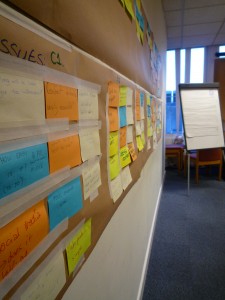The role and challenges of the Customer Experience Professional
The varied and vital role played by customer experience professionals was put under the spotlight last week at the CXPA’s European Insight Exchange in London.
Attended by CX practitioners from Spain, Finland, France, Ireland and Zimbabwe as well as the UK the event showed that wherever we are, the expectations of what customer experience people can do for a business are rising just as quickly as consumers’ own expectations about what the business can do for them.
Mark Horsley, CEO of Northern Gas Network spoke with an understated passion about creating the right environment for his people; allowing them to be heard, to flourish and to contribute in a way that gives customers better experiences. Mark is CEO of an organisation whose customers have little choice and so could be forgiven for being more transactional than relationship-focused. Nothing could be further from the truth and it was refreshing to hear customer experience’s positive double-whammy being reinforced; it’s not just about doing the right thing but a stronger, more certain business future will follow too.
It’s always easier said than done and even the many awards Northern Gas Network has collected have not come about overnight. In that context, the CXPA event helped share challenges, solutions and lessons learned, providing valuable insights and much food for thought.
I was privileged to lead one of the sessions on the role of the Customer Experience Professional. It’s a subject hounded by many questions. How, for example, does the role change depending on how senior the person is or how mature their company’s CX is? Is it about helping everyone to “get it” or about galvanising sceptical stakeholders behind a common goal? Is it about stopping the business making mistakes by bringing to life the reality of what it’s like to be a customer? Or all of the above and more?
In searching for answers there were common, related themes including: driving a customer agenda can be a lonely place, it’s difficult to spur people into action when there’s no burning platform and the size of the task can be overwhelming. The Insight Exchange provided some clues as to how might we overcome these challenges.
A lonely voice
It’s often the case that organisations who need a CX focus the most are the least open to change. Where the hard focus is purely on costs, revenue and operational metrics it takes a brave person to bring up the subject of emotions and the laws of unintended consequences. Yet where that happens, the biggest positive changes can occur too.
The advice is to find peers who are of the same mind, who understand that by stopping the things that customers don’t value or by fixing the causes of niggles and complaints there are quick wins to be had. I’ve seen it work at some of the largest companies in their sectors globally; it’s not a Hollywood script but one person starts with passion, belief and a real customer understanding and before long people right across the business are sitting up and taking notice. In the the early days it may take the form of chats in the coffee queue or creating a “Customer Experience Steering Group” but by being the catalyst, creating a movement from within and armed with proof of concept, the conversations at more senior level becomes much easier.
No burning platform
The ‘do nothing different’ option is very tempting in an organisation that is – possibly unintentionally – myopic and complacent. They say: “We’re making money, we have satisfied customers and our employees know how their performance is measured. Why change?”.
As a customer experience professional we can help them see things differently. We can show them how expectations are changing and rising exponentially, driven by companies they interact with and read about in other sectors. We can show them the true sentiment in the customer satisfaction surveys and how they are not measuring the things that customers say are now most important. We can get under the skin of the employee survey to find out from those who know the processes best about how work-arounds and hand-offs are broken and are running inefficiently.
There may not be an obvious platform burning brightly but what company with an ambition for long-term survival would not want to extinguish and smouldering embers underground before it’s too late.
It’s overwhelming
The nature of customer experience means that as a way of thinking it can help pretty much every part of the business. Whether informing strategic decisions, helping to mitigate risks or defining brand promises, CX has a role to play and with it, a raft of desirable actions.
In theory at least, we have the ability to understand whatever we need to about our customers. We can have as much data as we can process. Some actions will require a quick conversation to tweek a process and some, like changing the culture, will be longer-term. All though are necessary and therefore it can be a daunting prospect.
There were two suggestions here. Firstly, don’t try to do everything. As with the burning platform, keep one eye on the bigger picture but use short-term quick wins to gain momentum and start changing things, little by little. Not everything needs weeks and months courting stakeholders to prepare a business case. The more people can see the positive impact the more doors will be easier to open. The breadth of advocates will grow, more resources will become available and the right changes will happen. Eventually it’ll just become the way the organisation does business.
The second, linked, point is the prioritisation process. By understanding what touchpoints in a customer’s journey are most important and how well they are delivered, the focus straightaway is ensuring the areas that matter most are done consistently well or on stopping wasted effort where things are not valued.
The Insight Exchange was just that; swapping thoughts, ideas, lessons learned the hard way. Many left inspired, many were reassured that they are already on the right lines and many headed back to the office with new ideas about tackling their biggest challenges.
What is clear though is that the true role of a CX professional goes way beyond most job description templates. In an ideal world, customer experience people would do themselves out of a job when the business becomes self-regulating. The good news, or bad news depending on how you look at it, is that on the whole we’ve a long way to go. As co-Chairman Ian Golding put it, the day had the look of a counselling session given how significant the challenges and opportunities, in equal measure, are.
It’s what makes it such a compelling and rewarding profession.
Thanks for reading the post, I’d be really interested to hear what you think. I’m Jerry Angrave, specialising in customer experience consultancy and professional development. I’m a Certified Customer Experience Professional and an authorised trainer for the CCXP exam. Do get in touch if you’ve any questions – I’m on +44 (0) 7917 718072, on email at [email protected] or on Twitter @JerryAngrave.





